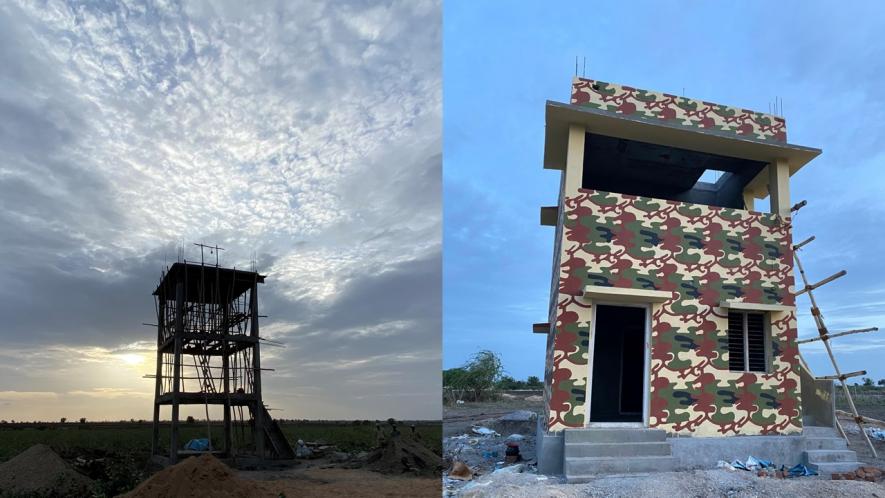After its Disappearance from Karnataka, the Great Indian Bustard GIB Vulnerable in Many States

Great Indian Bustard. | Image Courtesy: Wikipedia
“If the Great Indian Bustard (GIB) goes extinct, whom will the wildlife department of Karnataka save?” asks M.K. Ranjitsinh, former director of Wildlife Preservation of India and one of India’s most prominent wildlife conservationists. He is critical of wildlife officials from Karnataka for creating tall structures in the breeding habitat of the GIB in Siruguppa Taluka in Ballary district, and, as a result, causing the disappearance of the bustards.
After Rajasthan, Siruguppa was the only breeding area for this critically endangered bird species in the world.
“The bustards are nowhere to be seen ever since officials got multi-storied watch-towers and anti-poaching cells constructed in the middle of the breeding area of Siruguppa. Despite objections raised by scientists, experts and conservationists from all over, the department is still continuing with the construction,” he told NewsClick.
There will be no breeding this year, as the bustards have gone away, he said, with sadness in his voice. Ranjitsinh is the architect behind the Wildlife (Protection) Act, 1972.
It was due to his petition in 2019 that a high-powered committee headed by chairman Asad Rahmani was formed by Supreme Court on July 15, 2019. The committee was tasked with framing and implementing an emergency response plan for protecting the GIB. He said that the apex court would be apprised of the current developments in Ballary.
Principal Chief Conservator of Forests, Ajai Misra, told NewsClick that the two watch-towers and anti-poaching cells had been built to protect wild animals from poaching.

Photo credit- SK Arun
Ranjitsinh responded to it, saying that the structures could be single-story in design. According to him, the structures need not have been built exactly in the middle of the bustard’s habitat; the bird has already registered a high mortality rate by colliding with high-rise structures, high-tension electricity lines and wind mills in the country, due to their poor frontal vision.
Members of both the committees, constituted by the Karnataka wildlife department to probe construction issues, have recommended the removal of these new structures as well as removal of new plantation of trees, S.K. Arun, member of one of the investigating expert committees, told NewsClick.
Losing its last breeding ground in peninsular India will be a major setback for GIB conservation, as the situation is already grim in other states for the bustard.
For instance, there is little hope for Gujarat, Maharashtra and Andhra Pradesh, where only 15 female bustards are left, without any males. They are doomed to disappear as a result. Madhya Pradesh has already lost the GIBs.
The last remaining viable population on earth – about 120 bustards – are now confined to two places in Jaisalmer, Rajasthan.
The five-year GIB Species Recovery Program of captive breeding the birds by artificially incubating them began in Rajasthan in 2019. The Union Environment Ministry, the Forest Department of Rajasthan, Wildlife Institute of India and the International Fund for Houbara Conservation, Abu Dhabi, are joint in-charge of running this program. A hatchery has already been constructed in Jaisalmer for the purpose.
Rajasthan has declined to give its male GIB to Gujarat for breeding purposes, turning the tables on a state which has been adamant to not share its Asiatic lions with Madhya Pradesh for more than a decade now. “There are around five females in Gujarat, but shifting a male bird will not prove fruitful as there are lots of high-tension electricity lines. The government needs to lay those electricity lines underground,” said Sutirtha Dutta, a scientist with the Wildlife Institute of India.
The GIB, one of the heaviest flying birds with a wing span of over seven feet, is also the state bird of Rajasthan.
With the Great Indian Bustard, experts are concerned that India may lose a second mega-species within a short span if the situation does not improve. (The first was the Asiatic cheetah in 1952.)
“The manner in which Rajasthan is adding power mills and windmills in the last surviving breeding area of the GIB... I told the Chief Minister to his face, this bird will be extinct from here as well. If it happens, Rajasthan will have the dubious distinction of being the only political entity in the history of the world which has lost a living emblem,” said Ranjitsinh.
He alleged that the Rajasthan government was doing nothing to move the electricity lines underground, and was stalling under the pretext of waiting for funds from the Centre. “It is as if the state government has nothing to do with this Bustard. It seems that they are using this time to intensify the installation of high-tension electricity lines,” he added.
Similarly, the Gujarat government is spearheading the installation of more electricity lines in Kutch, in the vicinity of a bustard habitat.
“We all want development but it should not be at the cost of sacrificing nature and wildlife. It is the job of the administration to make the adjustments to strike a balance between both,” Ranjitsinh added.
He said that the state government and the Centre are duty-bound to protect the environment and wildlife (under Article 48-A) according to the Constitution of India. “Else, they must declare that we have nothing to do with environment and wildlife and close down these concerned departments and the environment ministry. There is no need for pretence,” he fumed.
According to Dutta, if the population of GIB or any other species declines in an area, they are no longer of much ecological value.
“It is only if they are in large numbers that they serve the ecology by maintaining the insect population or dispersing seeds,” he said. “There are a few species which have charisma attached to their conservation – all other species get benefits such as protection and maintenance of their habitat as a result. It is as we see in the case of tigers,” he added.
He said that the GIB is one such iconic species for grasslands and deserts which are devoid of big predators and other charismatic species. “By safeguarding the habitat of bustards, all other species are automatically conserved. It is high time that the Centre and the state government conserve the grassland, which has been considered wasteland in policies since colonial times, to save the species which are solely dependent on this habitat,” he added.
The writer is a freelance journalist who writes on the environment.
Get the latest reports & analysis with people's perspective on Protests, movements & deep analytical videos, discussions of the current affairs in your Telegram app. Subscribe to NewsClick's Telegram channel & get Real-Time updates on stories, as they get published on our website.
























